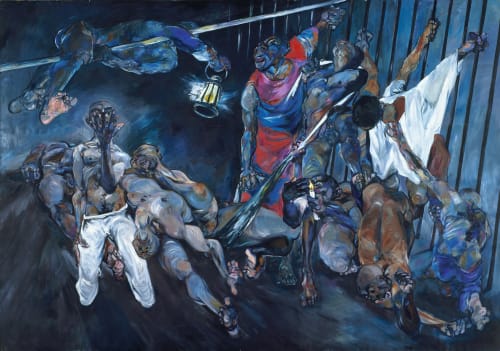Essay for exhibition at Garelick’s Gallery, Detroit, and Forum Gallery, New York, 1961–62
IN EUROPEAN PAINTING TODAY Peter de Francia in many ways occupies a very special position which can be linked with the lone stand of other artists in different parts of the world whose work runs counter to the mainstream.
What links these artists is not a common “school” or similar aesthetic leanings, but their moral outlook, that of faith in reality and in man. Each in his own way seeks to portray man set against the reality of contemporary life and to offer a new and truthful image of him.
Peter de Francia is one of the few modern artists who have not wished to take part in the chorus of sensational experimentalism to which the majority of young artists gravitate today. He has taken upon his shoulders all the responsibilities, difficulties and risks in the search into figurative art in the present time. His painting is based on reality and life, taking its most dramatic and violent aspects, and sometimes reaching peaks of intense tragedy. This passionate feeling for human affairs is always to be found in his work, whether he is tackling great dramatic themes of modern life, or simple subjects such as nudes, portraits or people in trams or in the street.
One can discern in modern painting a general shift in taste towards the “nouveau style.” It is interesting to note that this return to favor of the experiments of the first twenty years of this century leaves out the entire line of research on which cubism was founded both in content and in form. The latest pictures of de Francia seem to be linked precisely with this line of research. He shares a bond of culture, understood as living culture, with the Picasso of 1906–8; the Picasso inspired by Iberian and Negro art, and with Derain. De Francia has other links of the same nature, with Constant Permeke. In my view this is a very important cultural reference, precisely because it leads to a strongly expressive form of art, but not to “expressionism” proper. Because he has chosen to work in this way, Peter de Francia is able to portray a dramatic reality, rich in contrasts, and at the same time rejecting all forms of evasion, including that which lurks behind expressionist condemnation.
There is nothing unhealthy, corrupt or complacent in Peter de Francia’s work. In a period in which artists are trying to mirror catastrophe and the hopeless breakdown of values and forms, he is helping to strengthen faith in man, and he succeeds in giving a virile and active feeling even in tragedy and horror. He also makes no concessions to naturalistic or academic realism, which, though its interpretations may differ widely, is postulated today as the only alternative to abstract art. It is for this reason too that I consider the stand that Peter de Francia has taken a correct and courageous one, and his painting of special significance in the current European art scene.
